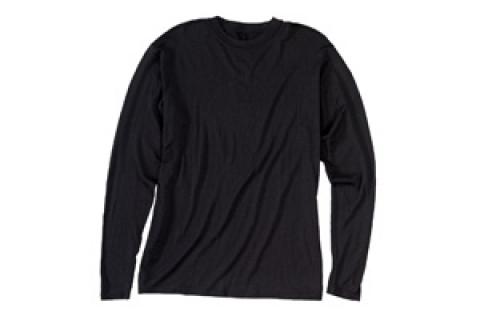
While on a recent late-season muzzleloader deer hunt in western Illinois with Golden Triangle Whitetails, we experienced some very cold temperatures for part of the hunt. It certainly made sitting in a tree stand all day a challenge. Fortunately I was well-prepared with lots of cold weather clothing, and I was able to endure. However, I wasn't always as well-equipped, and I have learned over the years what's needed. In this two-part article, I'll outline my formula for success. Let's start with clothing.
 |
| The author likes Merino wool for a base layer. |
Build a Good Base Layer of Clothing
It is essential to start with a good base layer of long underwear and long-sleeved undershirt. The purpose of these garments is not only insulation but also to wick moisture away from your skin. As much as we may try to avoid it, it is hard not to work up a bit of a sweat heading to a tree stand or ground blind in the pre-dawn darkness, especially if you have to trudge through deep snow. If your base layer doesn't draw the moisture away from your skin, you will get cold as soon as you get to your stand and stop moving. And you will stay that way. These base layers come in different weights, ranging from light to heavy/fleece, depending upon the temperatures you will be facing and how active you intend to be.
I have been using such garments made of various polyesters, blends and other high-tech fabrics for years, but this year I tried a set made of 100 percent Merino wool and I was very pleased. They are light, warm, comfortable, offer good moisture transfer, and are very soft. I can't stand a scratchy material next to my skin, so I was a bit worried about wool, but these pieces are great. The only material to avoid is cotton, as it will retain the moisture next to your skin. Regardless of the material, it needs to cover your entire legs and torso and fit fairly tight but stretchy so that it is in constant contact with your skin in all areas in order to wick away the perspiration.
Dress in Layers for Changing Conditions
The key to staying comfortable under a variety of changing conditions throughout a day is to dress in layers. This allows you to add or remove items as conditions warrant.
On top of the base layer, I will add a mid-weight, long-sleeved hunting shirt. I just purchased a new one made of 100 percent wool. Although I didn't get a chance to try it this season, I'm looking forward to using it next year. Yes, it is scratchy, but it shouldn't be a problem over top of my base layers.
For pants, I am a big fan of Columbia Expedition Ridge Wool Hunting Pants, if the temperatures aren't too cold. If they are, I go with an insulated bib, with a light fleece pant underneath. If sitting all day in extremely condition weather, I will wear the wool pants instead underneath the bib.
On top of the shirt, I have usually worn a fleece vest, but in keeping with my recent trend toward tried-and-true natural materials, I wore a wool sweater this year and was very pleased with it. Again, it is very soft and comfortable. In extremely cold conditions, I will wear both items.
I will usually top off these items with a hooded coat/parka of some sort of synthetic, waterproof material. Here again, I have recently been looking at wool as a possible alternative, as the beauty of wool is that it retains nearly all of its insulating properties even when wet. It is also completely silent going through the brush, making it a great choice for stillhunting or spot-and-stalk techniques.
Finally, I make sure that my extremities, namely my feet, hands and head are properly covered, as those get cold first. For my feet, I have a number of different boots that I choose from based upon how much walking I will do. If I'm going to sit all day, it's hard to beat a pair of heavy pac boots. If I will be doing quite a bit of walking, I like a hunting boot with at least 1,200 grams of Thinsulate insulation.
For my hands, I carry several different weights of gloves in my pack, and I tend to wear a lighter one on my right hand as I need to be able to feel the trigger when shooting. I also highly recommend a hand muff, which allows me to wear lighter gloves for shooting, while still keeping my hands warm.
I tend to lose a lot out heat out the top of my head, so I also carry a variety of head gear in my pockets and pack, consisting of a ball cap, a beanie and a knitted face mask. These pieces, along with the hood of my parka, allow me to switch back and forth and even combine items to stay comfortable in a variety of conditions and temperatures.
In Part 2 of staying warm when hunting in extreme cold we'll look at other strategies to stay warm and comfortable while hunting in extreme cold.
Good hunting
- 5543 views

